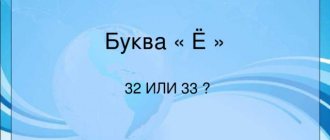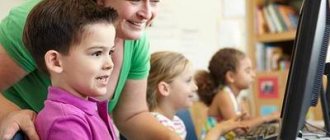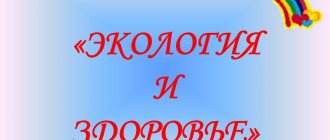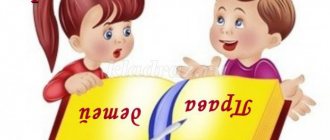Student portfolio builder (online)
The editor has released the main pages (separator pages) of the primary school student's portfolio.
A built-in collection of ready-made templates will help you create the necessary pages.
In the future, using the clipart library, you will be able to create your own inimitable and unique works, with subsequent saving to a local disk.
A4 file size 1132x1600 .jpg
Portfolio content:
Title page
The portfolio begins with a title page, which contains basic information: last name, first name, patronymic, contact information and photo of the student.
Section "My World"
The section contains any information that is important and interesting for the child (Page separator)
My name
Information about what a name means can be written about famous people who bore and bear the same name. If your child has a rare or interesting surname, you can find information about what it means
My family
Family composition. You can talk about each family member or write a short story about your family.
My city
A story about your hometown (village, village), about its interesting places. Here you can also place a diagram of the route from home to school drawn together with your child.
My friends
Photos of friends, information about their interests and hobbies.
My hobbies
A story about what a child is interested in. Here you can write about classes in the sports section, studying at a music school or other educational institutions of additional education. (Page separator)
My school
A story about school and teachers, short notes about favorite school subjects. (Page separator)
My favorite items
School subjects - notes about your favorite subjects. (Page separator)
Section "My studies"
The section is dedicated to school subjects (tests and tests, projects, reviews of books read, graphs of reading speed growth, creative work...) (Page separator)
Section “My social work”
All activities that are carried out outside the framework of educational activities can be classified as social work (assignments). (Page separator)
Section “My creativity”
In this section you can place your creative works: drawings, crafts, poems, creative works, competitions, olympiads, projects, awards, classes in additional education institutions. (Page separator)
Section "My achievements"
Subject Olympiads, testing in subjects, competitions and events, diplomas, certificates, diplomas, letters of gratitude, final certification sheets, etc. (Page separator)
Section “Feedback and Suggestions”
At the end of each school year, the teacher writes a testimonial for the student, which is included here. Here the child himself can write his wishes to teachers and his home school, how he would like them to be and what he would change. (Page separator)
Section "Works I'm Proud of"
In this section, the child places what is of greatest value to him. (Page separator)
"CONTENT"
Contents of the student's portfolio
Additional sheets
Lined sheet
Photo sheet (4 vertical)
Photo sheet (4 horizontal)
Blank sheet
Additional information on maintaining and filling out a portfolio>>>
Student portfolio. Sample
Not every school has made it a rule to create a portfolio for a student. For now, the idea is being implemented as an experiment. However, most likely, a portfolio will still become a mandatory attribute of every student. I want to offer options:
1. Where to start?
The personal portfolio of a high school student of a specialized school is presented in the form of personal diaries. With their help, boys and girls, together with a psychologist, teacher, and class teacher, conduct a reflective analysis of the changes occurring with them at the stage of transition from school childhood to adulthood. These changes relate to strengthening individual resources, strengthening the leadership position as the basis for the future sphere of professional activity, and focusing activity to ensure future success in life. The text of the manual is presented in such a way that its individual pages can be reproduced and used as visual handouts for work in classroom hours and elective courses. Based on the content of the proposed materials, the teacher and psychologist can create various portfolio options at their discretion. For class teachers, psychologists, organizers of educational work in the school and additional education system.
Compiling a portfolio is, indeed, most relevant in secondary and primary schools. And here’s the question: does a portfolio have the right to exist in elementary school and, if so, in what form can it be presented? Of course, many sections from Portfolio 9 are not suitable. What to replace them with? Should I make my portfolio comprehensive or limit myself to one part of it? All these questions can be answered by thinking about what the main goals and objectives of portfolio management in primary school are.
2. Goals and objectives.
One of the main tasks of teaching and education in primary school (I hope!) is to identify and develop the child’s individual creative abilities. And here is how the teacher from St. Petersburg Olga Ukhanova1 defines the main goals and objectives of maintaining a portfolio in primary school: - creating a situation of success for each student, increasing self-esteem and confidence in one’s own capabilities; — maximum disclosure of the individual abilities of each child; — development of students’ cognitive interests and formation of readiness for independent learning; — formation of an attitude towards creative activity and creative activity skills, development of motivation for further creative growth; — formation of positive moral and moral qualities of the individual; — acquiring reflection skills2, developing the ability to analyze one’s own interests, inclinations, needs and correlate them with available opportunities (“I am real”, “I am ideal”); — formation of life ideals, stimulation of the desire for self-improvement. To solve these problems (according to many experts), it is necessary to shift the emphasis, placing the main emphasis not on a portfolio of documents, but on a portfolio of creative works. In other words, the “CREATIVE WORKS” section should become the main and main thing, the “Official Documents” section should fade into the background and be used only as an appendix!
“The student’s daily creative process must be recorded.” This is the motto for working with a portfolio that is recommended in elementary school. _______________
1 Published in the newspaper “Primary School”.
2 Reflection is a tendency to analyze one’s experiences and think about one’s internal state. Reflection on oneself, knowledge and analysis of one’s own mental processes and states. It disrupts a person’s life and reduces his adaptation with both excess and lack of self-knowledge.
3. The main thing is not victory, the main thing is participation!
The undoubted value of a portfolio is that it helps to increase the student’s self-esteem, maximize the individual capabilities of each child, and develop motivation for further creative growth. Therefore, it is extremely important to learn for yourself and explain to your child that compiling a portfolio is not a race for diplomas and all kinds of certificates! What is important is the process of participation in educational activities or creative work, and not its result.
Long-term research by psychologists has forced many specialists in the field of education to accept the point of view according to which the leading characteristic of a creative personality should be considered not “outstanding abilities” (high intelligence, creativity, etc.), but its motivation3 (life goals). It is this that is considered by many as the decisive factor in realizing the creative potential of an individual. _______________
3 Motivation - motives that cause activity and determine its direction.
4. What does an elementary school student’s portfolio look like?
There are no strict requirements (state standard) at the moment. And it pleases! After all, working on a portfolio is a good opportunity to express yourself, approach this task creatively, and come up with something of your own, original. As a rule, the school administration gives advice and recommendations on design. The only thing to be wary of is that the primary school student’s portfolio is not called “Portfolio of my achievements” (“My achievements”, etc.) and that the section documenting these achievements (all kinds of certificates and certificates). Let's talk about the dangers of this approach a little further. In the meantime, let me remind you that to “fight” this kind of obligation and other “administrative imbalances” there is such a body as the school’s board of trustees. Advocate for your children's interests. Take action!
5. A possible option for compiling a portfolio for an elementary school student.
5.1. Sample portfolio structure
Option 1. BLACK AND WHITE SHEETS (for self-coloring)
Sequence of actions 1. Download the separator sheets and insert sheets and print them.
2. Color the black and white sheets.
3. Fill out the title page.
4. We put the title page, separators and inserts into the folder, supplemented with suitable materials (for detailed recommendations, see below in Chapter 5.3).
5. Fill out the last sheet “Contents”.
5.3. How and what to fill a primary school student’s portfolio with
TITLE PAGE
Contains basic information (last name, first name and patronymic; educational institution, class), contact information and photo of the student.
We consider it important to let the child choose the photo for the title page. You should not put pressure on him and persuade him to choose a strict portrait. Give him the opportunity to show himself as he sees himself and wants to present himself to others.
SECTION “MY WORLD”
Here you can place any information that is interesting and important for the child. Possible sheet headings: • “My name” - information about what the name means, you can write about famous people who bore and bear this name. If your child has a rare or interesting last name, you can find information about what it means. • “My Family” - here you can talk about each family member or write a short story about your family. • “My City” - a story about your hometown (village, hamlet), about its interesting places. Here you can also place a diagram of the route from home to school drawn together with your child. It is important that dangerous places are marked on it (road intersections, traffic lights). • “My friends” - photos of friends, information about their interests and hobbies. • “My hobbies” - a short story about what a child is interested in. Here you can write about classes in the sports section, studying at a music school or other educational institutions of additional education. • “My School” - a story about the school and the teachers. • “My favorite school subjects” - short notes about your favorite school subjects, built on the principle “I like... because...”. Also a good option called “School Subjects”. At the same time, the child can speak out about each subject, finding in it something important and necessary for himself.
SECTION “MY STUDIES”
In this section, the worksheet headings are dedicated to a specific school subject. The student fills this section with well-written tests, interesting projects, reviews of books read, graphs of reading speed growth, and creative works.
SECTION “MY PUBLIC WORK”
All activities that are carried out outside the framework of educational activities can be classified as social work (assignments). Maybe the child played a role in a school play, or read poetry at a formal assembly, or designed a wall newspaper for a holiday, or performed at a matinee... There are a lot of options. It is advisable to design this section using photographs and short messages on the topic.
SECTION “MY CREATIVITY”
In this section the child places his creative works: drawings, fairy tales, poems. If you have completed a large piece of work (craft), you need to include a photo of it. Parents need to give their child complete freedom when filling out this section!
Important! If the work took part in an exhibition or participated in a competition, it is also necessary to provide information about this event: name, when, where and by whom it was held.
It would be nice to supplement this message with a photo. If the event was covered in the media or on the Internet, you need to find this information. If carried out by an Internet portal, print out the thematic page
SECTION “MY IMPRESSIONS”
In elementary school, children take an active part in excursion and educational programs, go to the theater, to exhibitions, and visit museums. At the end of the excursion or hike, it is necessary to offer the child creative homework, by completing which he will not only remember the content of the excursion, but will also have the opportunity to express his impressions. If this is not practiced at school, it makes sense for parents to come to the teacher’s aid and develop and reproduce a standard “Creative Assignment” form. At the end of the academic year, it is possible to hold a presentation of creative assignments with mandatory awards for the best works in several categories.
SECTION “MY ACHIEVEMENTS”
Certificates, certificates, diplomas, letters of gratitude, as well as final attestation sheets are posted here. Moreover, in elementary school one should not separate in importance academic success (a certificate of merit) and success, for example, in sports (diploma). It is better to choose the arrangement not in order of importance, but, for example, in chronological order.
SECTION “REVIEWS AND WISHES”
This section is not often included in an elementary school student’s portfolio. It's a pity! Nothing increases a child’s self-esteem more than a teacher’s positive assessment of his efforts. Unfortunately, schoolchildren’s diaries are full of either unflattering remarks like “Not ready for the lesson!”, or unreflective praise like “Well done!” What if instead of the same “Well done!” give a little feedback in your portfolio? For example: “Took an active part in preparing for the extracurricular event “The Price of Victory.” I learned and recited the poem superbly. I prepared the wall newspaper myself, and involved my comrades in the design.”
We consider it important to add a feedback sheet, as well as a form where teachers can express their recommendations and wishes, for example, based on the results of the school year.
SECTION “WORKS THAT I AM PROUD OF”
At the beginning of the new academic year, it is necessary to carefully study the portfolio and analyze the material collected in it. When moving to a senior class, the contents of all sections must be completely updated. Less significant works and documents are extracted (can be placed in a separate folder), and those that are of greater value are placed in a special section. It could be titled “WORKS THAT I’M PROUD OF”
AND THE LAST SECTION - “CONTENTS”
Do not get carried away with the design of this sheet, as it will have to be updated quite often.
6. Important to remember.
In the first grade, when a child is just starting to work on compiling a portfolio, he cannot do without the help of his parents. But as he grows up, this help should be kept to a minimum. From the very beginning, try to structure your child’s work in such a way that he himself puts some effort into creating a portfolio. In the process of work, the process of understanding one’s achievements inevitably occurs, the formation of a personal attitude towards the results obtained and awareness of one’s capabilities.
Gradually, “man for the community” gives way to “man for himself.” Did you notice? Therefore, one of the goals of pedagogy now has become the education in a child not of social abstract needs, but of what he needs personally for his self-realization.





